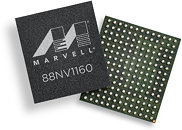Wednesday, August 10th 2016
Marvell Introduces the 88NV1160 DRAM-less SSD Controller
Marvell, a world leader in storage, cloud infrastructure, Internet of Things (IoT), connectivity and multimedia semiconductor solutions, today announced the expansion of its solid-state drive (SSD) portfolio to include the 88NV1160 Non-Volatile Memory (NVM) Express DRAM-less SSD controller. Marvell's 88NV1160 DRAM-less SSD controller provides the industry's leading performance per Watt and up to 1600MB/s read speeds. The 88NV1160 can be used in a single ball grid array (BGA) package SSD, as well as in a standalone controller in a tiny 9x10mm package which makes it compatible with M.2230 and M.2242 form factors. These features make the 88NV1160 optimized for a new generation of slim computing devices such as productivity tablets and ultrabooks. The new controller is currently available for sampling to key customers globally.
"As the world's leading storage controller provider, Marvell has a long track record of bringing to market world-class innovations, including the pioneering integration of Host Memory Buffer technology into DRAM-less products. Working closely with other ecosystem leaders, Marvell has continued to advance the industry and drive a new generation of low power, small form factor mobile computing systems," said Dr. David Chen, Vice President of SSD Business at Marvell Semiconductor, Inc. "The 88NV1160 controller is optimally engineered for high performance tablets and ultrabooks, providing unparalleled performance per Watt and the largest NAND compatibility on the market."The 88NV1160 is the latest solution in Marvell's award-winning line of DRAM-less SSD controllers which includes its 88NV1120 SATA and 88NV1140 PCIe Gen3x1 NVMe products. Marvell's 88NV1160 enables Peripheral Component Interconnect Express (PCIe) Gen3x2 Non-Volatile Memory Express (NVMe) BGA SSD, and provides full support for 2D and 3D NAND, ONFI and Toggle, MLC, TLC and QLC. The 88NV1160 facilitates BGA SSD support for both 16x20 mm and 11.5x13mm form factors.
Key features of Marvell's 88NV1160 include:
"As the world's leading storage controller provider, Marvell has a long track record of bringing to market world-class innovations, including the pioneering integration of Host Memory Buffer technology into DRAM-less products. Working closely with other ecosystem leaders, Marvell has continued to advance the industry and drive a new generation of low power, small form factor mobile computing systems," said Dr. David Chen, Vice President of SSD Business at Marvell Semiconductor, Inc. "The 88NV1160 controller is optimally engineered for high performance tablets and ultrabooks, providing unparalleled performance per Watt and the largest NAND compatibility on the market."The 88NV1160 is the latest solution in Marvell's award-winning line of DRAM-less SSD controllers which includes its 88NV1120 SATA and 88NV1140 PCIe Gen3x1 NVMe products. Marvell's 88NV1160 enables Peripheral Component Interconnect Express (PCIe) Gen3x2 Non-Volatile Memory Express (NVMe) BGA SSD, and provides full support for 2D and 3D NAND, ONFI and Toggle, MLC, TLC and QLC. The 88NV1160 facilitates BGA SSD support for both 16x20 mm and 11.5x13mm form factors.
Key features of Marvell's 88NV1160 include:
- NVMe support over PCIe Gen3x2
- Fully hardware automated NVMe 1.3 support with Host Memory Buffer support
- Low power management (L1.2) design
- Powerful dual core ARM Cortex-R5 CPUs
- Embedded SRAM with hardware accelerators to optimize IOPS performance
- ONFI3 and Toggle2 NAND support
- NANDEdge LDPC error-correction technology boosts SSD endurance and reliability and supports 15nm 2D TLC and 3D TLC/QLC
- Full turnkey firmware and manufacturing support compatible with mainstream NAND
- 28nm low power CMOS process

7 Comments on Marvell Introduces the 88NV1160 DRAM-less SSD Controller
Can't wait to see end-products based on this controller.
88NV1160 is PCIe 3.0x2 and has 4-channel NAND interface.
So, with newest 3D TLC it is possible to build a 3TB NVMe SSD on 88NV1160 (but highly improbable).
And since we are talking low-end, it will also benefit SoC platforms, like low-power systems from AMD and Intel.
For example it will be possible to have a NVMe SSD, NIC and MiniPCI-e WiFi card on the same board with only x4 PCI-E lanes, like on current BayTrail boards (no need for hubs/bridges/switches etc).